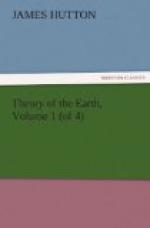But do not let me take the advantage of this error of our author with regard to the mineralogy of Scotland, and thus draw what may be thought an undue conclusion in favour of my general theory; let us go over and examine the continent of Europe, and see if it is any otherwise there than in Britain. From the granite of the Ural mountains, to that which we find in the Pyrenees, there is no reason, so far as I have been able to learn, to conclude that things are formed either upon any other principle, or upon a different scale. But, instead of one five hundred part, let us suppose there to be one fiftieth part of the earth in general resting upon granite, I could not have expressed myself otherwise than I have done; for, when I maintained that the earth in general consisted of stratified bodies, I said that this was only nine tenths, or perhaps ninety-nine hundredths of the whole, and I mentioned that there were other masses of a different origin, which should be considered separately. Our author, on the contrary, asserts that the Old and New Worlds, as well as Scotland, are placed upon granite as a basis, which he says is according to the testimony of all mineralogists. I shall have occasion to examine this opinion of mineralogists, in comparing it with those masses of granite which appear to us; and I hope fully to refute the geological, as well as mineralogical notions with regard to that body. In the mean time, let me make the following reflection, which here naturally occurs.
My Theory of the Earth is here examined,—not with the system of nature, or actual state of things, to which it certainly should have corresponded,—but with the systematic views of a person, who has formed his notions of geology from the vague opinion of others, and not from what he has seen. Had the question been, How far my theory agreed with other theories, our author might very properly have informed his readers that it was diametrically opposite to the opinions of mineralogists; but, this was no reason for concluding it to be erroneous; on the contrary, it is rather a presumption that I may have corrected the error of mineralogists who have gone before me, in like manner as it is most reasonable to presume that our author may have corrected mine. Let us then proceed to examine how far this shall appear to be the case.
Our author has stated very fairly from the Theory, viz. That all the strata of the earth, not only those consisting of calcareous masses, but others superincumbent on these, have had their origin at the bottom of the sea, by the collection of sand, gravel, shells, coralline, and crustaceous bodies, and of earths and clays variously mixed, separated, and accumulated. He then adds, “Various geological observations contradict this conclusion. There are many stratified mountains of argillaceous slate, gneiss, serpentine, jasper, and even marble, in which either sand, gravel, shells, coralline, or crustaceous bodies are never, or scarce ever found.”




